
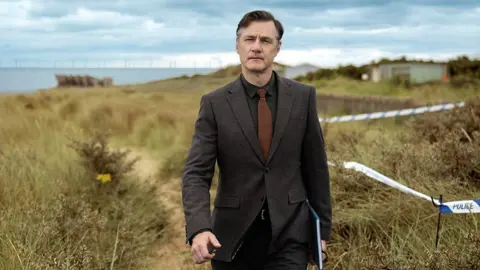 BBC
BBC
The return of BBC series Sherwood has once again had viewers gripped.
The hard-hitting, gritty drama focuses on gun crime and gangs in post-industrial Nottingham.
But some viewers have taken to social media to debate the credibility of its opening plotlines.
Warning: This article contains spoilers from episodes of the second series
Sherwood is written by the award-winning Nottinghamshire playwright, James Graham.
It opens with a disclaimer. The drama is “inspired by stories and events” in the author’s community, but “all characters and events have been fictionalised”.
I have been covering those real-life crime stories for the BBC in Nottingham for more than two decades.
Much of the latest series of Sherwood feels strikingly familiar.
Some plotlines echo headlines from the early 2000s when the tabloids branded Nottingham as “Shottingham” and “Assassination City”.
Gun crime spiralled out of control amid murders, revenge and police corruption.
So how closely does the fictional plot of Sherwood reflect those real-life characters and crimes?
The murderer


Oliver Huntingdon plays a volatile new character, Ryan Bottomley, who sparks a cycle of revenge by shooting and killing the son of a notorious criminal.
Ryan’s character mirrors Michael O’Brien, who was jailed for the fatal shooting of Marvyn Bradshaw outside the Sporting Chance pub in Bulwell, Nottingham, in August 2003.
O’Brien’s intended target was believed to have been Marvyn’s teenage friend, Jamie Gunn, who was in the same car.
Jamie was the nephew of a notorious Nottingham crime boss called Colin Gunn, and died of pneumonia a year later after going into a spiral of decline.
As O’Brien was sentenced in 2004, he shouted abuse at Marvyn’s family who were sitting in the public gallery. The fictional Ryan in Sherwood did the same thing.
The revenge killing

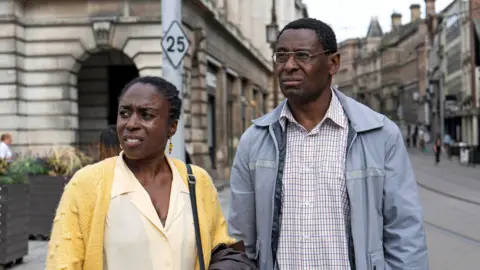
Ryan’s adopted mother, Pam Bottomley, and her brother, Dennis, are played by Sharlene Whyte and David Harewood.
The fictional Bottomleys’ story in Sherwood closely mirrors what happened to Michael O’Brien’s innocent mother and stepfather, Joan and John Stirland, two decades ago.
The Stirlands fled their home in Nottingham after shots were fired through their front window.
Then in August 2004, the couple were shot dead by two hitmen in their seaside bungalow at Trusthorpe on the Lincolnshire coast.
They were traced to Trusthorpe by Colin Gunn, one of three men who were jailed for life for conspiracy to murder the Stirlands. The two gunmen were never caught.

 Lincolnshire Police
Lincolnshire Police
The corrupt detective
In Sherwood, Pam Bottomley tries to raise concerns with her police contact shortly before the couple’s murder. That call is intercepted by an officer who lies to her and does not pass on those concerns.
Could that fictional officer be inspired by a corrupt detective who fed intelligence to Colin Gunn and was paid in designer suits?
Det Con Charles Fletcher searched for confidential information about Gunn only two days before the Stirlands were shot dead in Trusthorpe.
He had also searched for intelligence about the Stirlands’ previous address in Nottingham after shots were fired through their window.
The former detective was jailed for seven years after being caught by internal investigators who bugged him at a Nottingham police station.
The undercover cop

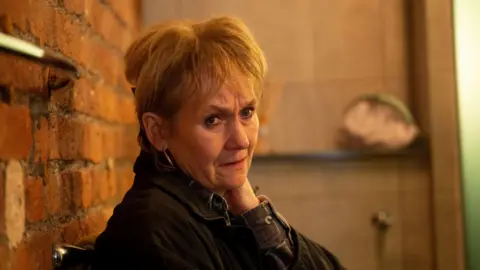
Lorraine Ashbourne returns to Sherwood as Daphne Sparrow, the matriarch of a crime family who had been an undercover police officer during the miners’ strike.
Nottinghamshire’s notorious real-life “spycop” had a very different cover story.
Mark Kennedy was a married Metropolitan Police officer who spent seven years posing as an environmental activist.

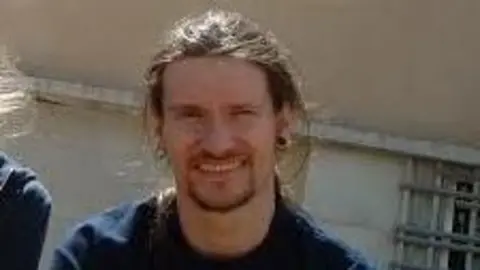 Kate Wilson
Kate Wilson
Kennedy infiltrated Nottingham’s Sumac Centre, and formed intimate relationships with several women under his alias, Mark Stone.
He was unmasked in 2010 after a trial collapsed, when it emerged that Kennedy was part of a group accused of plotting to shut down Ratcliffe-on-Soar power station in Nottinghamshire.
That prompted similar revelations about other officers, which led to a major public inquiry into undercover policing.
The violence reduction chief


David Morrisey’s character, Ian St Clair, has left his job as a senior police officer and now heads up Sherwood’s fictional “Violence Intervention Team”.
His storyline reflects the careers of several real-life former police officers after they left the Nottinghamshire force.
David Wakelin went on to head the local Violence Reduction Unit, which supported vulnerable young people to deter them from serious crime.
Another former Nottinghamshire police officer, Gary Godden, is now the local police and crime commissioner.
Mr Godden recently told the BBC that good policing is not just about enforcement. The fictional Ian St Clair used an almost-identical line in Sherwood.

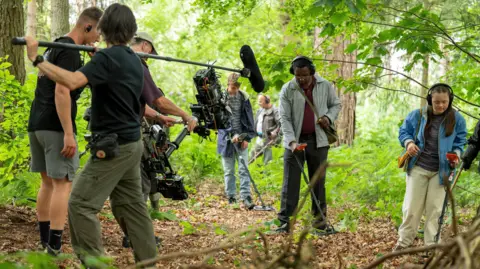
If you’ve been watching Sherwood, you’ll know there are clear differences between those real events and the storyline that it inspired.
The fictional plot and characters have taken this drama to a very different place.
But it is shining a light on why Nottingham went through such dark times all those years ago.
And it raises a simple question: Is truth stranger than fiction?
The final episodes of Sherwood are on BBC One at 21:00 on 8-9 September and then available on the BBC iPlayer








